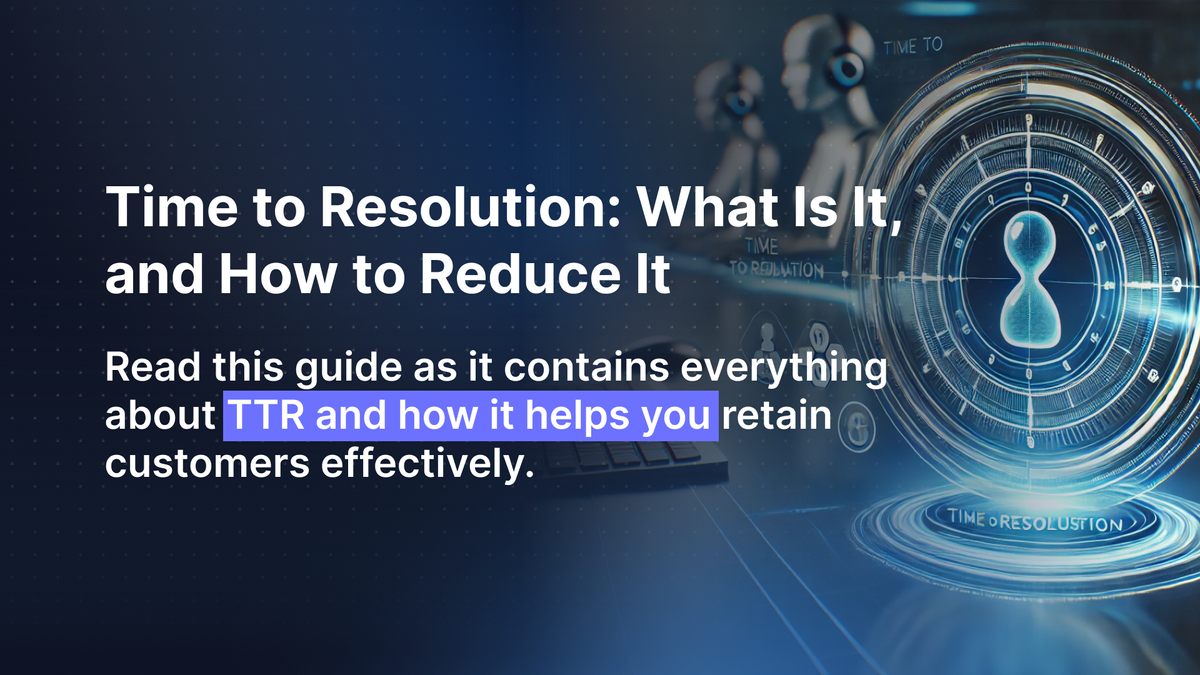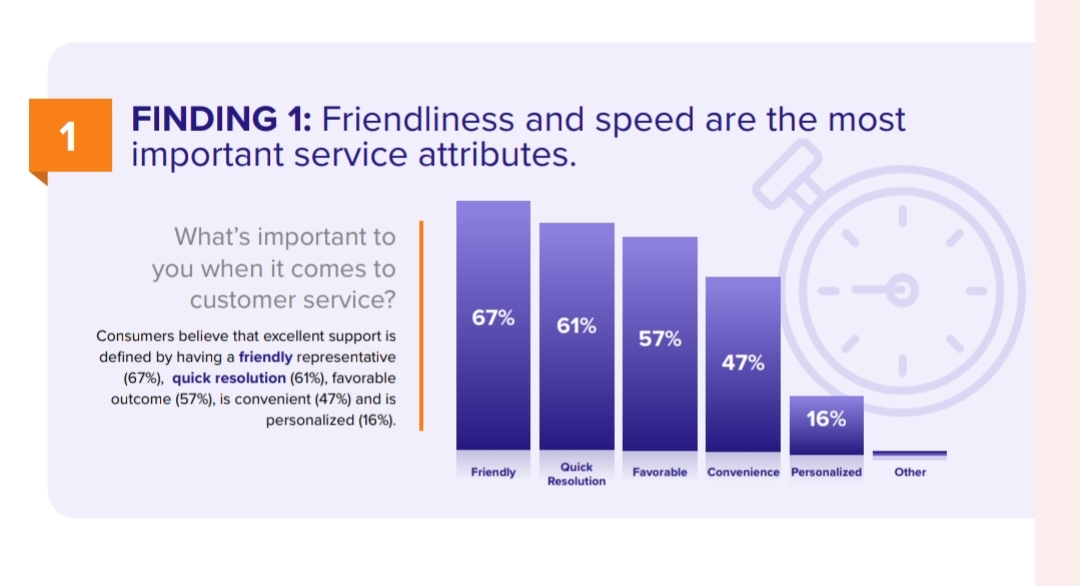Are you wondering how to reduce Time to Resolution (TTR) in customer service?...

Imagine that a customer contacts your help desk when he encounters a glitch with the hope of an immediate solution. But all he gets is wait, wait, and wait. The result? Disappointment, frustration, and loss of trust! In fact, this negatively impacts your business as customers feel less worthy. According to a survey, 60% of customers believe that excellent customer service is when they get a quick resolution of their problem.
So, it's crucial to track and measure ‘time to resolution’ in your business strategy to provide a smooth experience. Let's have a detailed look at what time to resolution is, why it's important, and how do you calculate resolution and lower it to make your customers happy and satisfied.

Source: The Netomi Pulse Report Finding
The question is, what does TTR mean? Well, TTR stands for ‘time to resolution’. It (TTR) is a key customer service metric that measures the time it takes to solve customer issues. TTR is also known as mean time to resolution (MTTR).
Simply put, it's a time when a customer opens a support ticket by sending an email, chat, or calling until the issue is entirely resolved and the ticket is marked as closed. Good customer service is mandatory, as 96% of U.S. customers find it extremely important, leading to loyalty and satisfaction.
Though TTR is not the only element to evaluate the performance of your business, it's one of the most critical metrics. It depicts the efficacy and productivity of your customer support.
A lower TTR shows that customers are satisfied with support service and their queries are resolved. In contrast, a higher TTR shows that issues aren't being addressed promptly, resulting in dissatisfied customers.
You’ll be surprised to know that 78% of U.S. consumers stopped doing business with at least one company or canceled a subscription due to poor customer service, while 31% did it several times. This shows how important it is to provide accurate and quick resolutions to drive loyalty and business success. Measuring TTR is crucial due to these reasons:
Customers' loyalty and trust are necessary for your business success. Research shows that customer loyalty can be gained by quality customer service. In fact, for 77% of customers, good customer service is fundamental to earning loyalty. It's human nature that if they're frustrated with some issue ( e.g. the website isn't working), they want it to be solved immediately. And if they don't get a response within minutes or some hours, they will be dissatisfied and lose the trust of your brand.
Time matters to your customers and business alike. Customers can’t wait for hours to get a response, and you can't afford to lose clients. They're more happy to get an accurate response within hours than getting the same reply within days. However, 60% of customers define a quick response as 10 minutes or less.
Time to resolution isn't only a timer to tell you how much time has elapsed in resolving customers’ issues. It actually shows the overall customer experience. Along with TTR, other metrics like the ones below are also important.
TTR is calculated by measuring the time taken to resolve the issue when a customer raised it. It's not measured after a single resolution but collectively after a definite period. For this, the average time of resolution is taken:
Average Resolution Time = Total resolution time / No.of tickets solved
The total resolution time is calculated by measuring the time it takes to resolve a query. Then subtract the start time from the end time.
No. of tickets solved is the total number of queries resolved.
The average resolution time varies from industry to industry, e.g, a tech company requires more time to resolve a technical or complex issue.
Moreover, businesses should segregate the issues into simple and complex. Simple issues can be solved immediately without a support agent by using Chatbots or adding FAQs. You can use chatbots for quick replies to repetitive questions. Aidbase assists you in creating chatbots for your business, leading to a better customer experience.
The estimated time of resolution across all industries together is 24.2 hours.
Businesses might face some challenges that increase TTR:
The top challenge businesses face is the lack of standard protocol for issue resolution. If different support agents use different protocols to solve queries, it will harm resolution time. So, you need to set standard protocols and train your team for customer handling.
If you don't have clear visibility of how much time it takes to resolve a particular query, and what bottlenecks are in your process, it will lead to higher TTR. So, have a system for measuring resolution time and enhancing support ability.
Sometimes, the support team has to solve complex issues, or they need long explanations, which can take time to resolve.
Let's discuss how you can reduce resolution time:
Create a knowledge base for your customers through FAQs pages, articles, how-to guides, and visuals to help them navigate the website. Research shows that 81% of customers prefer to self-serve before contacting support. The best part about these resources is customers are more likely to get an answer in less time. Also, reducing the number of queries passing to support agents.
What's better than solving customers’ queries in seconds and leaving them satisfied? That's possible when you automate different processes using chatbots. They are equipped to solve simple tickets on their own, freeing human teams to do the more challenging job.
Training your support team and introducing specialization based on their expertise should be the priority of any business. This way, tickets are automatically directed to the expert agent in a particular issue. Also, they feel more empowered and work hard to resolve customers’ queries better and faster.
Use appropriate tools to reduce average resolution time and customer dissatisfaction. According to a survey, 44% of customers believe waiting for a response is their major source of frustration. Also, the more manual the process is, the more customers will have to wait and ultimately feel frustrated. So, provide support team appropriate tools and technology like customer relationship management (CRM) softwares, templates, and diagnostic tools.
Prioritizing and triaging ticketing is crucial to avoid overwhelming your team with a myriad of tickets all at once. It's possible that low-priority or easy-to-solve issues may rack up as the team is busy catering to complex issues.
The outcome? More resolution time! So, to counter this, assign some agents to low-priority, quick-resolution tickets while others on high-priority issues. Also, it's best practice to prioritize solving issues of VIP customers, those about to make a purchase, escalated or angry customers.
So, time to resolution is an important metric to evaluate customer experience and how well your team is performing. According to studies, a 10% improvement in TTR can lead to a 1% increase in customer retention and a 5% increase in customer satisfaction. And that's highly crucial for the success of your business!
Want to lower the resolution time? Aidbase can help! It's an AI support and AI customer service platform that can help SaaS startups, e-commerce businesses, and agencies to improve customer service and revenue with their AI chatbot and ticketing system.